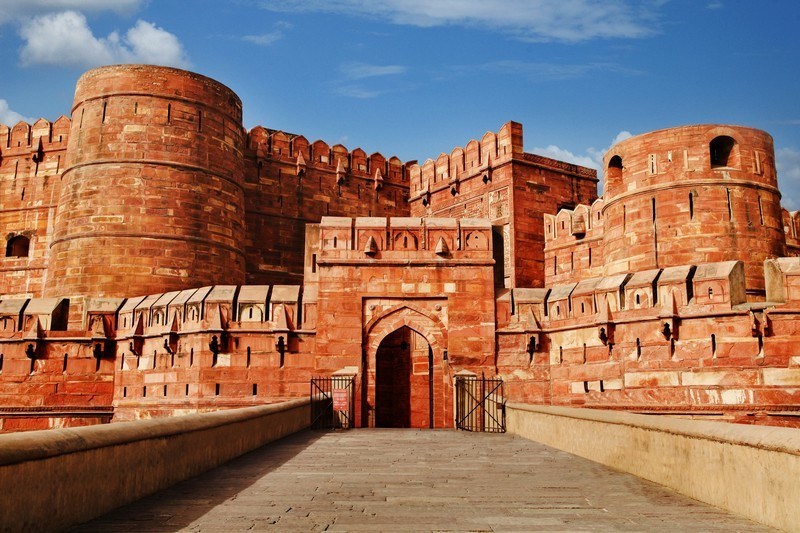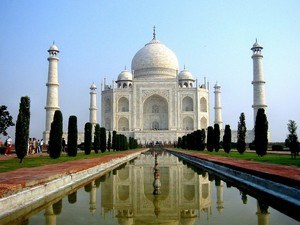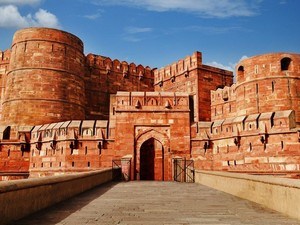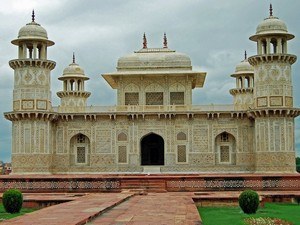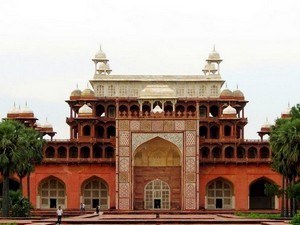Agra Fort / Agra Red Fort, Agra - Timings, History, Architecture, Best Time to Visit
Photo Credit: Flickr
 India | Uttar Pradesh | Agra
India | Uttar Pradesh | Agra
 #2 of 26 Places to Visit in Agra
#2 of 26 Places to Visit in Agra
 Distance (From Agra Cantonment): 4.5 Kms
Distance (From Agra Cantonment): 4.5 Kms
 Trip Duration (Including Travel): 1 Hour
Trip Duration (Including Travel): 1 Hour
 Transportation Options: Bus / Cab / Auto
Transportation Options: Bus / Cab / Auto
 Travel Tips: This is UNESCO World Heritage Site.
Travel Tips: This is UNESCO World Heritage Site.
About Agra Fort
At a distance of 4.5 Km from Agra Cantonment Railway Station, and 2.5 Km from Taj Mahal, the Agra Fort is a historical Mughal fort situated on the banks of Yamuna River in Agra, Uttar Pradesh. Also known as the Lal Qila or Red Fort, it is recognized as the first grand citadel of the Mughals and is one of the key attractions included in the Agra heritage tour packages. For an extended period, this massive fortress functioned as the center of power, where prominent emperors of the prosperous Mughal dynasty governed. Currently, it is designated as a UNESCO World Heritage Site, representing a living testament to the architectural excellence and military strength of the Mughals.
History of Agra Fort
Agra Fort was initially a brick fortress known as Badalgarh, which was under the control of Raja Badal Singh, a Hindu Rajput king, in 1475 AD. Sikandar Lodi was the first Sultan of Delhi to relocate his capital from Delhi to Agra. Following the death of Sikandar Lodi in 1517, his son Ibrahim Lodi maintained possession of the fort for nine years until he was defeated and killed in the first battle of Panipat in 1526. During the Lodi era, several palaces, wells, and a mosque were constructed within the fort. After the First Battle of Panipat in 1526, the victorious Babur took residence in the fort, specifically in the palace of Ibrahim Lodi. He subsequently constructed a baoli (step well) within the fort. The emperor Humayun was crowned in the fort in 1530. However, Humayun faced defeat at Bilgram in 1540 at the hands of Sher Shah. The fort remained under the Suris until 1555, when Humayun managed to reclaim it.
Upon Akbar's arrival in Agra, he recognized the city's significance and designated it as his capital. Akbar restored the remnants of the Badalgarh Fort and renovated it using red sandstone sourced from Rajasthan. Approximately 4000 workers were engaged in this project, which was completed over a span of eight years (1565-1573). Shah Jahan, Akbar's grandson, demolished some of the existing structures within the fort to construct his own, resulting in the Agra Fort's current appearance. Aurangzeb imprisoned his father Shah Jahan in the fort for eight years until his death in 1666, after which he was buried in the Taj Mahal. The fort was seized by the Marathas and ultimately by the British in 1803 AD. Following independence, the fort came under the jurisdiction of the Government of India.
Architecture of Agra Fort
Covering an extensive area of 94 acres, the Agra Fort showcases a fusion of Hindu and Islamic architectural styles. The fort, which has a semi-circular layout, boasts walls that rise 70 feet high, narrow defensive walkways, and concealed tunnels for royal escapes. Surrounding the fort are two walls, or ramparts, constructed from red sandstone, featuring large circular bastions at regular intervals. The fort is accessible through four gates located on each side - Ghazni Gate, Khizri Gate, which opens towards the riverfront, the Delhi Gate and the Lahore Gate, also referred to as the Amar Singh Gate. The impressive Delhi Gate is regarded as the most magnificent of the four and a remarkable example of Akbar's era. A wooden drawbridge facilitated crossing the moat to access the gate from the mainland. Currently, the northern section of the fort is utilized by the Indian military, restricting public access to the Delhi Gate. Presently, the Amar Singh Gate to the south serves as the only entry point to the fort.
Abdul Fazl, a historian in Akbar's court, notes that 5000 structures were elegantly constructed here in Bengali and Gujarati styles. Unfortunately, most of these buildings have now vanished. Shah Jahan himself ordered the demolition of some to create space for his white marble palaces. Subsequently, the British destroyed a majority of the remaining structures to build barracks. Only about 30 Mughal buildings have endured on the southeastern side, among which the Moti Masjid, Diwan-i-Khas, Diwan-i-Aam, and Jahangir Mahal stand out as notable structures.
Jehangir Mahal
Upon entering the Agra Fort through the Amar Singh Gate, one of the initial structures you will come across is the Jehangiri Mahal, also known as Jehangir Palace. Constructed by Akbar for his son, it served as a residence for royal women. The design of the Jehangir Mahal is straightforward, built from stone and adorned with numerous intricate carvings.
Khas Mahal
Khas Mahal is another significant edifice constructed by Shah Jahan within the Agra Fort. This private palace for the emperor offers a view of Angoori Bagh. It showcases classical Persian and Islamic influences, featuring intricate marble inlay work and graceful arches. The windows, adorned with decorative latticework, are also noteworthy. This structure served as the emperor's sleeping quarters, known as 'Araamgah'.
Shah Jahani Mahal
Shah Jahani Mahal is situated in between the Khas Mahal and Jahangiri Mahal. It is the earliest attempt of the Mughal emperor Shahjahan to convert an existing red stone building into a white marble structure. It has a large hall, side rooms and an octagonal tower on the riverside.
Sheesh Mahal
One of the most remarkable structures within the Agra Fort, the Sheesh Mahal, also known as the Mirror Palace, is situated in the northeast section of the complex, beneath Diwan-e-Khas. Constructed between 1634 and 1640, the Sheesh Mahal functioned as the royal bath for the Queen, designed with thick walls to preserve a cool and refreshing atmosphere. The palace is distinguished by its walls and ceilings embellished with elaborate mirror mosaics, which create an enchanting radiance throughout the space.
Diwan-i-Khas
Located to the right of the Sheesh Mahal, Diwan-i-Khas was built around 1653 and functioned as a site for private discussions and cultural events among rulers, ambassadors, and nobles. It captivates with its unique marble exterior embellished with beautiful Persian-style floral designs. The interior showcases elegant marble columns, detailed scalloped archways, and semi-precious stone inlays. It consists of two large halls: an outer columned hall and an inner enclosed hall. The latter once accommodated the famous Peacock Throne, which was later moved to Delhi's Red Fort in the 18th century. Next to this is the Muthamman Burj, also known as the Shah Burj, which served as a summer retreat. This was where Shah Jahan spent his final days, gazing out at the tomb of his beloved wife, the Mumtaz Begum.
Diwan-i-Aam
Diwan-i-Aam served as the hall where emperors communicated with the general public and attended to their grievances. Constructed in 1628, this expansive, flat-roofed structure is open on three sides and is supported by 48 intricately carved pillars, each adorned with elegantly engraved arches. Initially, Shah Jahan commissioned it to be built from red sandstone. Subsequently, it was plastered to achieve an appearance resembling white marble.
Moti Masjid
Situated in proximity to the Diwan-i-Aam hall is the magnificent Moti Masjid, also known as the Pearl Mosque. Renowned for its impressive grandeur and tranquil atmosphere, it is a remarkably beautiful edifice within Agra Fort. This mosque, constructed from pristine white marble, features three domes and a spacious courtyard. Currently, the mosque is not open to visitors. Adjacent to the Moti Masjid is the Mina Masjid, which served as the private shrine of Emperor Shah Jahan. Additionally, one can visit the nearby Nagina Masjid, which was established by Emperor Shah Jahan as a private mosque for the ladies of the court.
Light & Sound Show in Agra Fort
The Agra Fort hosts an enchanting Light & Sound Show named 'Rang-e-Agra,' which recounts the history of the city through a combination of lights, sound, and narrative. The duration of the show is 45 minutes and is presented in both English and Hindi, taking place from 7:30 PM to 9 PM in the Diwan-i-Aam area. The performance primarily revolves around the romantic tale of Shah Jahan and his beloved wife, Mumtaz. Attendees will also have the opportunity to view a stunning replica of the Taj Mahal set against the backdrop of the stage. Furthermore, the beautifully illuminated Agra Fort can be admired at night. Tickets can be purchased online as well as at the Agra Fort location. Each show can accommodate only 300 guests, so it is advisable for visitors to secure their tickets in advance.
Agra Fort Timings
Monday: 6 AM - 6 PM, Light & Sound Show: 7:30 PM in Hindi & 8:30 PM in English
Tuesday: 6 AM - 6 PM, Light & Sound Show: 7:30 PM in Hindi & 8:30 PM in English Wednesday: 6 AM - 6 PM, Light & Sound Show: 7:30 PM in Hindi & 8:30 PM in English Thursday: 6 AM - 6 PM, Light & Sound Show: 7:30 PM in Hindi & 8:30 PM in English
Friday: 6 AM - 6 PM, Light & Sound Show: 7:30 PM in Hindi & 8:30 PM in English
Saturday: 6 AM - 6 PM, Light & Sound Show: 7:30 PM in Hindi & 8:30 PM in English
Sunday: 6 AM - 6 PM, Light & Sound Show: 7:30 PM in Hindi & 8:30 PM in English
Agra Fort Entry Fee
Entry: Rs.50 for Indians, Rs.650 for Foreigners & Free for Children (3 - 15 years)
Light & Sound Show: Rs. 300 for Indian Adults & Rs. 150 for Indian Children (8-17 Years) & Rs. 800 for Foreign Adults & Rs. 400 for Foreign Children (8-17 Years)
Tips for Visiting Agra Fort
1. Remember wear comfortable footwear and breathable attire while exploring Agra Fort.
2. Ensure you carry an adequate supply of water to stay hydrated during the day.
3. Use sunscreen and bring along a scarf and a hat to shield yourself from the sun.
4. Make sure to book your tickets in advance for the light & sound show.
5. Opt for a guided tour to enhance your experience.
Best Time to Visit Agra Fort
The best time to visit Agra Fort is during the cooler months, specifically from November to February, when the climate is suitable for exploring the site. The monsoon season, which lasts from June to September, may bring intermittent rainfall, which could disrupt your travel plans. The summer months can be excessively hot, with temperatures exceeding 40°C, rendering sightseeing uncomfortable; thus, it is recommended to avoid visiting during this period. Early mornings or late afternoons provide the best experience, as the crowds are generally smaller and the temperatures are cooler during these times.
How to Reach Agra Fort
Agra is well connected by air, train and road. The nearest airport to reach Agra is Kheria Airport, located at a distance of 9 Km from the city and is connected to Delhi, Varanasi, Khajuraho, Gorakhpur, Jabalpur, Rajkot and Jamnagar. The city has four major railway stations - Agra Cantonment, Raja Ki Mandi, Agra Fort and Idgah Agra Junction. It has trains from Mumbai, Delhi, Amritsar, Hyderabad, Vizag, Chennai, Indore, Jammu, Jabalpur, Pondicherry, Chandigarh, Kalka, Hubli, Goa, Haridwar, Bhopal, Howrah, Patna, Dehradun, Bangalore, Allahabad, Jaipur, Trivandrum and Lucknow. Agra can also be reached by road from Lucknow, Kanpur, Delhi, Ahmedabad, Gwalior, Noida, Dehradun, Jaipur, Jodhpur, Indore, Haridwar and Vrindavan. Tourists can reach Agra Fort by using electric buses, cabs, Tongas, tempos, cycle rickshaws and auto rickshaws from all parts of the city of Agra.



